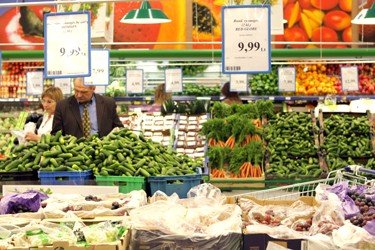
According to the affordability of goods and services in 2018, Lithuania lies ahead of many EU countries, the newest EU survey data says. However, Lithuanians are not rushing to celebrate; they say that the prices of food and cars are lower abroad. In the meantime, the economists note that life in Lithuania is indeed getting better and price differences depend on where and what we are comparing, Monika Kasnikovskytė wrote in TV3.lt.
The European Union office compared the prices of goods and services of every member state. The categories include food, alcohol and tobacco, clothes and footwear, restaurants and hotels, leisure and culture, telecommunications, transport, furniture and carpets, as well as accommodation and utility costs.
For comparison, the survey additionally includes the member states of the European Free Trade Association (EFTA), like Switzerland, Norway and Iceland.
However, it seems that Lithuanians are hesitant to acclaim statistics favourable to Lithuania. They assert that the prices of various goods in Lithuania are much higher than stated.
“My cousin who moved to England is shocked every time she visits Lithuania because of food prices”, “Food costs almost the same as in the United Kingdom”, “Food prices in Lithuania are a bit absurd; they are more or less like in Ireland, some of them even slightly higher. If you look at second-hand cars produced in the same year, they are much cheaper in Ireland. Those statistics are somehow useless…”. “Who needs statistics, which do not portray the reality,” Lithuanian Internet users were showing their resentment on Reddit.
Almost everywhere we pay less
As for the food prices, an unbeatable leader is Switzerland, where food prices are 63.6% higher than the EU average. The lowest prices are to be found in Romania, where they are smaller than the EU average by 34.6%. In Lithuania, food prices are lower than the EU average by 20.4%. In the rating from the most expensive to the cheapest countries, we are fourth from the bottom.
Alcohol and tobacco among EFTA members are most expensive in Norway; here, these products cost 126.1% more than the EU average. They are cheapest in Bulgaria, where alcohol and tobacco cost 41.8% less than the EU average. In Lithuania, these products cost 23.5% less than on average in the EU.
Rent for accommodation and utility costs are highest for the Swiss, who pay 73.9% more than the EU average. Bulgarians pay the least, rent and utility costs are 66.9% lower than the EU average. In the meantime, Lithuanians pay 57.4% less than the EU average.
Furthermore, furniture and carpets are cheaper than the EU average for Lithuanians too; we pay for these products, 22.5% less than the EU average. The ones who spend most in this category are the Danish (40.5% more than the EU average), the least – the Slovakians (20.1% less than in the EU average).
Transport and telecommunications are cheap
Trains, busses and other means of transportation in the EU cost most for the Icelanders, who pay 44.5% more than the EU average. The cheapest transport can be found in Bulgaria – 52.6% less than the EU average. Lithuanians pay 37.6% less than the EU average.
Lithuanians pay almost the least for telecommunication services, cell phones and Internet connexion, which is 39.2% less than the EU average. These products are most expensive for the Greeks who pay 57.6% more than on average in the EU and least expensive for the Polish, who pay 55.2% than the EU average.
Leisure and culture are most expensive for the Icelanders who pay 64.7% more than the EU average, cheapest – for the Romanians, who pay 41.6% less than on average in the EU. Lithuanians pay for culture and leisure 28% less than the EU average.
The most expensive hotels and restaurants are in Iceland, where people pay 76.1% more than the EU average. This luxury is cheapest in Bulgaria, where the cost is 53.4% lower than the EU average. Lithuania has prices, which are 28.6% lower than on average in the EU.
More expensive are only clothes and footwear
Nevertheless, in one category, Lithuania does exceed the average prices in EU, and that is clothing and footwear. Lithuanians pay 5.3% more than people pay on average in the EU. These products are most expensive in Iceland (49.9% more expensive than the EU average), least expensive – in Bulgaria (22.2% less than the EU average).
Luminor economist Žygimantas Mauricas deems this price difference has historically emerged as a result of relatively small competition in this sector in Lithuania.
“For this reason, the prices are on average higher than in other countries. Generally, the market for new clothes is not very big, partly Lithuanians are still buying second-hand clothes or not buying that much at all, so it is not a major economic sector. Consequently, competition and size of the economy are two things, which matter,” Ž. Mauricas was saying to tv3.lt.
Lithuanians do not hurry to celebrate
Swedbank chief economist Nerijus Mačiulis agrees that Lithuania with its capacity to purchase products is largely outstripping all the Middle and Eastern European countries, such as Greece, Portugal and Slovenia, and it even has reached the level of Spain. Thus, he also elucidates the question of why the average salary in Lithuania is lower than in most of these countries.
“There are particular reasons for this: lower prices, especially those of services; a lot of income not for hired labour and not fully legally declared income (such as business licences or individual practise certifications); a lot of services are available for free or almost for free, financed by the state (education, health services) or from charity and support organisations. Yes, free service quality and availability could be improved, but the point is the same – the neighbours’ grass is not greener, even if it looks like it through the fence,” N. Mačiulis wrote in his Facebook page.
Ž. Mauricas explains the negative approach of the public towards the published statistics with a simple comparison: “The retail food market is quite homogeneous in Lithuania, and the difference between higher and lower section shops is not that big. Thus, the lowest sector prices in Lithuania are not lower than in the United Kingdom. What is more, emigrants usually shop in lower sector shops and compare the prices with Lithuanian ones of the middle or higher sector. If one went to Sainsbury’s or similar shops, then prices are incomparably higher”.


Be the first to comment